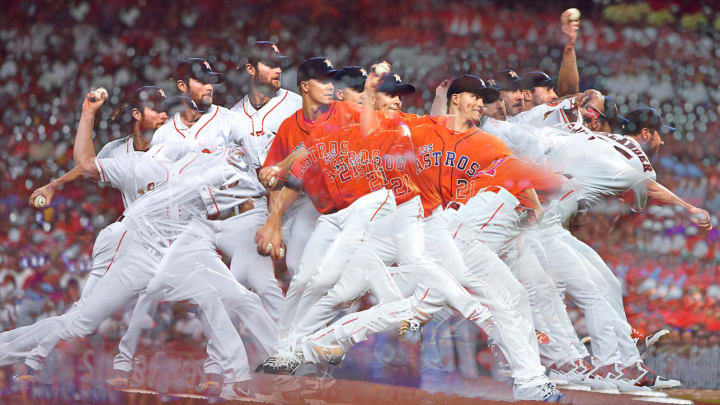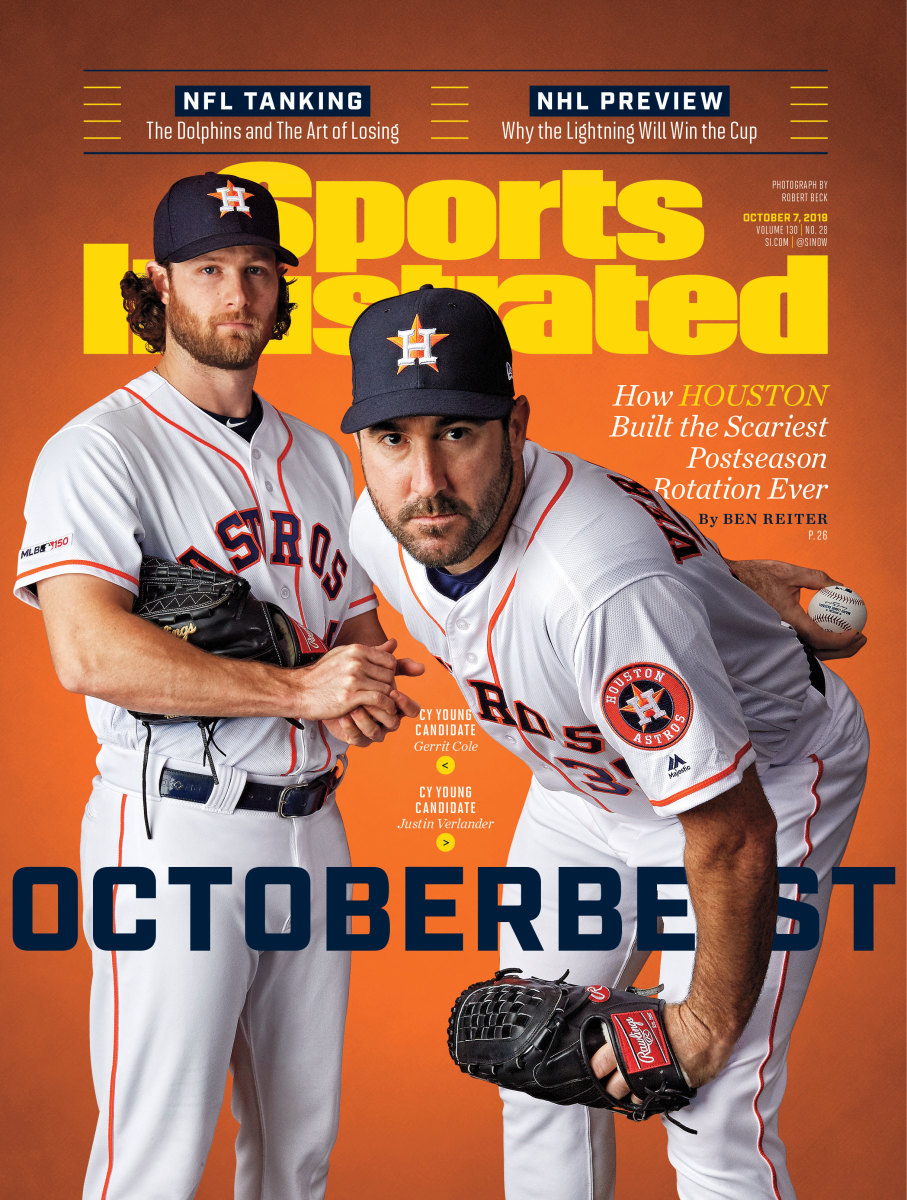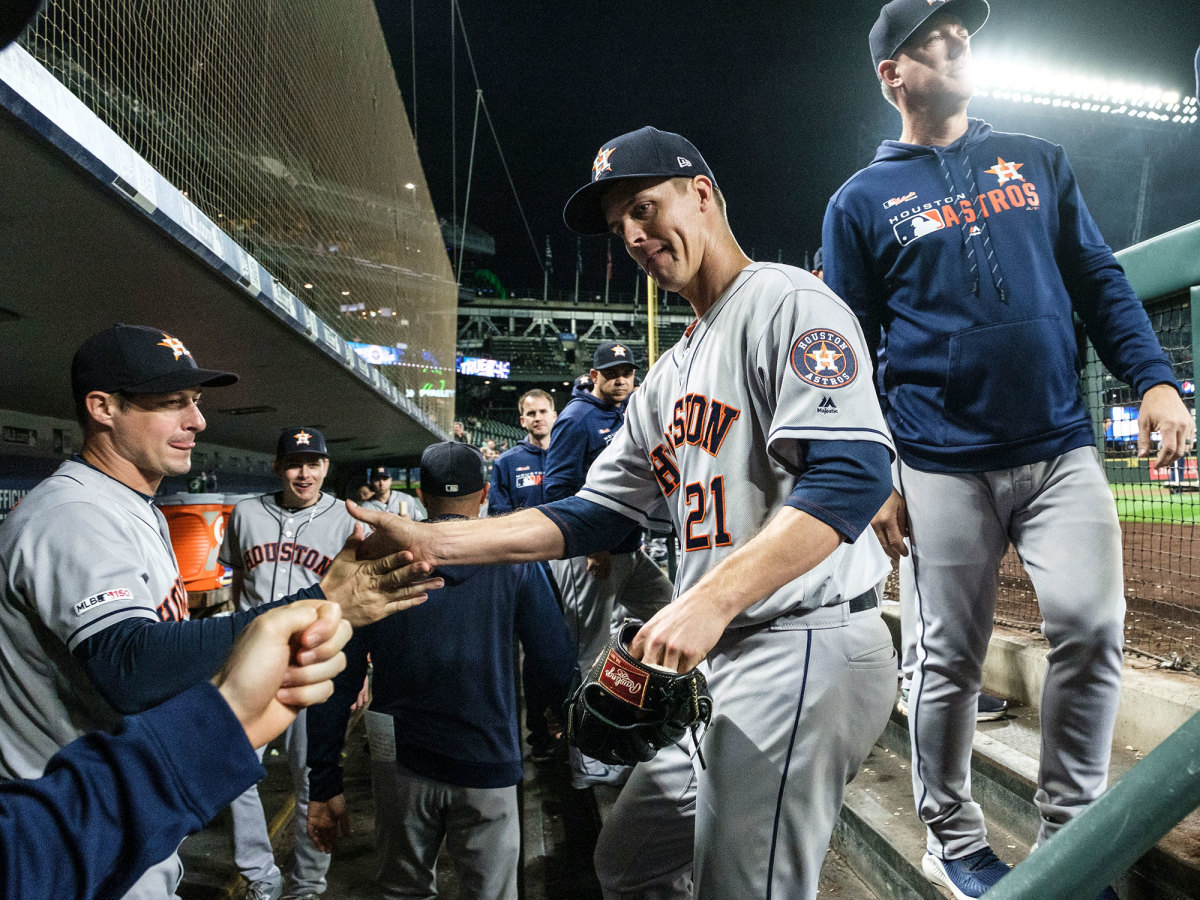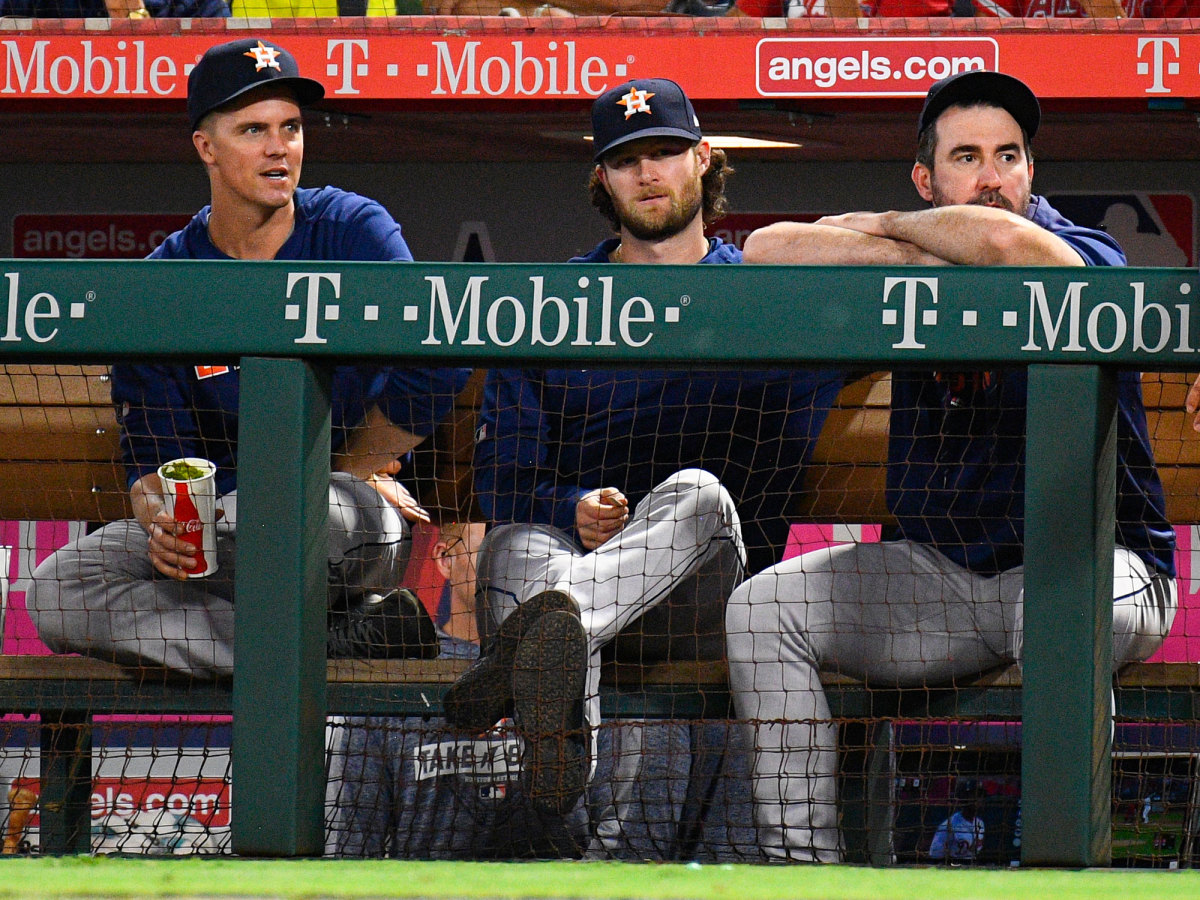How the Astros Nabbed Zack Greinke and Built a Postseason Rotation for the Ages


This story appears in the Oct. 7, 2019, issue of Sports Illustrated. For more great storytelling and in-depth analysis, subscribe to the magazine and get up to 94% off the cover price. Click here for more.
At 7 a.m. Central on July 31, Gina Luhnow descended the stairs of her house in Houston with her four-year-old son, Henry, in tow. When she had woken up, her husband, Jeff, was not in the bedroom, and soon she and Henry discovered why. He was in his home office, where he’d been experimenting with different combinations of names and numbers and pinging various members of his staff for several hours already—three hours, in fact, after a virtually sleepless night. The 12-cup carafe of Colombian dark roast he’d brewed had only one or two cups left. “Oh, boy,” Gina said. It was going to be another one of those trade deadlines.
The 53-year-old Luhnow, in his eighth season as the general manager of the Astros, is often accused of being entirely left-brained, and his sometimes bloodless analytical leanings served him well as he transformed the terrible club he’d taken over into the 2017 World Series champion, and then a consistent power. Even so, he swears he internalizes public opinion, and everywhere he went in midsummer—in radio interviews, down onto the field at Minute Maid Park, whenever he walked past a screen tuned to the MLB Network—he heard the same thing. Which was that even though the Astros seemed destined to become the sixth team ever to win 100 games in three straight seasons, and even though they already had the two best starting pitchers in the American League, they still needed to trade for another quality starter. The worst part was that everyone who said that was absolutely right.

He had acquired his dominant one-two rotational punch via trade. Justin Verlander came from the Tigers with officially two seconds to go before the waiver deadline—a secondary deadline that no longer exists—in late August of 2017, and Gerrit Cole arrived from the Pirates in a less stressful deal finalized the following January. Over their two seasons together, Verlander and Cole have ranked first and second (in some order) in the AL—and, in most of these categories, in the majors—in ERA, wins, strikeouts, batting average against and WHIP. Luhnow’s third starter, the veteran lefty Wade Miley, had at the time far outperformed his bargain one-year, $4.5 million contract; he was 9–4, with a 3.06 ERA.
But no one else had stepped up to secure the fourth, let alone the fifth, spot in the rotation, not Collin McHugh, not Brad Peacock, not Framber Valdéz, not Corbin Martin. Luhnow did not believe he needed another pitcher in order to win the AL West for the third consecutive season; the Astros were already 7 1/2 games up on the second-place A’s and had the league’s best run differential. He needed someone who could reliably start one or two games in a seven-game playoff series, four outings of which would undeniably go to Verlander and Cole. He needed someone who was as good or better than Miley.
The pool of pitchers like that who both existed and could conceivably be available in a trade was shallow. Luhnow and his staff identified just eight of them, maybe nine, and in the days leading up to the deadline they began to scratch names off their list. Marcus Stroman went from the Blue Jays to the Mets, and then Trevor Bauer from the Indians to the Reds; the Astros had been in talks for both and believed they might have even been the runners-up. Luhnow got the sense that other possibilities—like the Giants’ Madison Bumgarner, the Rangers’ Mike Minor and the Mets’ Noah Syndergaard and Zack Wheeler—weren’t going anywhere.
Well, they might have been, to Houston, had Luhnow been willing to send away one of his top three prospects— DH Yordan Álvarez, outfielder Kyle Tucker and pitcher Forrest Whitley—which he wasn’t, just as in previous seasons he’d refused to part with a rising young player named Alex Bregman. Bregman was now an MVP candidate, and Álvarez the probable Rookie of the Year, both long-term centerpieces of a club designed to contend for years. Most other clubs didn’t even bother asking about Álvarez, Tucker or Whitley, and the few who did were immediately rebuffed. If Luhnow was going to acquire the starter he needed, he would send away prospects drawn from further down his deep farm system, similar to the three- and four-player packages that pried away Verlander and Cole. He was prepared for the possibility that it wouldn’t happen. As he always told his staff, “Sometimes the best deals are the ones you don’t make.”

On the afternoon of July 30, about 24 hours before the deadline, Luhnow sat in the small office of his assistant G.M., Brandon Taubman, with a few of his other executives, discussing their options. There weren’t many. In fact, the odds were good they’d end up with nothing—the prudent thing to do, probably, but a disappointment. Then Jim Crane, the owner of the Astros, walked in and leaned against Taubman’s windowsill.
“What about Greinke?” Crane asked. Luhnow and his staff were surprised. They loved Zack Greinke, the 35-year-old Diamondbacks ace and former Cy Young winner who was at the time 10–4 with a 2.90 ERA. Everyone loved Zack Greinke. According to the Astros’ internal metrics, there was only one other realistically available player they might acquire who would boost the club’s chances of winning its second World Series in three years as much as Greinke. But Greinke also had two-and-a-half years left on the six-year, $206.5 million deal he’d signed with Arizona, and was one of the most expensive players in the game. Over the past half-dozen years, Crane had already sextupled his payroll, lifting it from the league’s lowest ($26.1 million in 2013) into the top 10 ($158 million on Opening Day). Could they afford Zack Greinke?
Crane smiled. “If we think the package of players we’d be giving up is reasonable,” he said, “we can get the money right.”
Luhnow immediately called his counterpart in Arizona, Mike Hazen. Earlier in the trading season, Luhnow had spoken with Hazen about a different target on the Astros’ eight-pitcher list: 27-year-old southpaw Robbie Ray. They hadn’t gotten much traction on those talks, and now Luhnow was inquiring about his No. 1, the centerpiece of Hazen’s franchise after he’d traded first baseman Paul Goldschmidt to the Cardinals over the winter. Hazen was clear: He had every intention of hanging onto Greinke unless presented with an offer that satisfied several of the Diamondbacks’ long-term needs. In fact he had a strong idea as to the precise package of Astros minor leaguers he’d consider. There were four of them. The Diamondbacks had been following each for a very long time.
The Astros are a data-driven organization, endeavoring to analyze the past to predict the future. Even at 35, Greinke represented as predictable an asset—both performance- and health-wise—as they could imagine. Over the past eight seasons, he’d pitched to an ERA worse than 3.50 just once, and had thrown fewer than 200 innings only twice. But Hazen wanted a lot for him. As Luhnow hung up the phone, he estimated that there was a 10% chance that Greinke would be an Astro in one day’s time. Still, he figured it was worth a mostly sleepless night, fueled by cup after cup of Colombian dark roast, to explore the possibility.
Luhnow didn’t want to reach out to Hazen too early the next morning. Hazen was in Phoenix, two hours behind Houston, and Luhnow was wary of appearing desperate. But he had an offer to make, and four or five hours before the 3 p.m. Central deadline he called Hazen. The offer consisted of two of the four prospects Hazen had wanted—-Martin, who was the Astros’ second-round pick in 2017, and slugger Seth Beer, their first-rounder the following June—and a lesser third piece, in addition to a request for Arizona to cover more of Greinke’s remaining salary than Hazen had indicated they’d be comfortable with.
Hazen said no.
As it turned out, the financial disconnect would be easier to overcome. Crane volunteered to directly call the Diamondbacks’ owner, Ken Kendrick; by the end of their conversation the men had an agreement. The accounting was somewhat complicated by the fact that about 30% of Greinke’s contract is deferred, to be paid in annual installments for five years after its expiration. The general takeaway was that Arizona would cover about $24 million of the approximately $78 million remaining on his contract, decreasing the Astros’ share of his annual salary to $21 million. While Greinke’s salary might still push them near the luxury tax threshold this season, and certainly would in the following two, the Astros could stomach that. What they still couldn’t stomach was losing the prospects that Hazen continued to demand.
With about an hour to go before the deadline, Luhnow called Hazen again with his best and final offer. Even though it made much of his staff uneasy, he would add a third player Hazen requested to the deal: pitcher J.B. Bukauskas, Houston’s first rounder in the 2017 draft. Luhnow had now agreed to send away the players who most considered to be his organization’s third-, fourth-, and fifth-best prospects, now that Álvarez was a big leaguer, in one fell swoop. Surely, that had to be enough.
At 2:30 p.m.—with half an hour to go—Hazen texted his response. The Diamondbacks were going to move on.
Luhnow’s phone rang. It was Crane, seeking an update. Luhnow told his boss that he felt as if the Astros were now negotiating against themselves—something he hated to do—and that the chances of pulling off the deal appeared dim, as nobody was particularly enthusiastic about the idea of giving up the fourth player, in addition to so much other prospect wealth. Who, Crane asked patiently, is the fourth player?
“Josh Rojas,” Luhnow replied.
Crane deeply respected his general manager’s process and judgment. He always had, which is why the owner stuck with Luhnow through the early years, when the Astros were the embarrassment of the league, losing 100 games three straight seasons. And he believed in him now. Although he did have one question. “Who is Josh Rojas?” Crane asked.

Rojas, Luhnow explained, had been the club’s 26th-round pick, out of the University of Hawaii in 2017. He had quickly worked his way up the Astros’ system, and this season, at 25, he’d broken out, batting .310 with 12 homers, 19 stolen bases, and an OPS near 1.000 in 53 games at Triple A Round Rock. While Rojas had never come close to making any of the public Top 100 lists—Baseball America, Baseball Prospectus and so on—it was clear that the industry valued him significantly more highly than those third parties did. He was one of those guys whom other teams almost always asked about. And he could play virtually every position on the diamond. Worst case, he’d prove an extremely valuable utility player for Houston, and soon.
“O.K.,” Crane said, measuredly. “So you’re holding up this deal for a late-round utility guy who is having a good year?”
Luhnow hung up and surveyed his war room one final time. While the final decision would still be his—even with Crane’s opinion clear—Luhnow likes to operate from a position of consensus, and for the members of his staff to freely express themselves. In a matter of minutes, momentum began to swing toward including Rojas, especially after a 30-year-old analyst named Adam Brodie spoke. I’d do it, Brodie said. I know it’s giving up a lot. But Greinke’s pitching so well, and we’d have him for two more seasons after this one, and we’re going to be in high-level contention in each of those too. It’s worth the cost.
At 2:37 p.m., 23 minutes before the deadline, Luhnow called Hazen, and then texted him when he didn’t get an answer. Houston would do the deal. Then Luhnow sat staring at his iPhone for what felt to him like 20 minutes, imagining all sorts of scenarios in which Hazen was busy finalizing a trade to send Greinke somewhere else. In reality, it was only 90 seconds until the three dots appeared on Luhnow’s screen, indicating Hazen was texting back.
Confirmed, Hazen’s text read.
It turned out that Hazen wasn’t talking to anyone else about Greinke. “We had been earlier in the day,” Hazen would say later. “But at that moment, with 30 minutes to go, it was going to be the Astros or we weren’t going to do a deal.”
There was no time to celebrate, for either side. There were medical reports to be reviewed, paperwork to be filed to the commissioner’s office. And with the minutes ticking down, there were other trades to be finalized too: the Astros, for instance, were simultaneously in the process of sending outfielder Derek Fisher to the Blue Jays for pitchers Aaron Sanchez and Joe Biagini and minor league outfielder Cal Stevenson; the Diamondbacks quickly acquired starter Mike Leake from the Mariners to fill the hole in the rotation left by Greinke.
There was one other issue: Greinke had started that afternoon’s game for the Diamondbacks in New York and had held the Yankees to two runs on two hits over five innings before a rain delay had interrupted his outing—a delay during which Luhnow and Hazen had finally agreed to the trade. At 2:53 p.m., Luhnow sent a final text to Hazen, making sure that Greinke was out of the game for good.
Yes, Hazen responded.
BREAKING: #Astros get Greinke.
— Ken Rosenthal (@Ken_Rosenthal) July 31, 2019
He had thrown his last pitch for Arizona. Both G.M.s kept glancing at MLB Network—whose analysts, as of 3 p.m. Central, were bemoaning what still appeared to be a dud of a deadline day—waiting for the news of their shocking blockbuster to break. The players involved had to be reached and informed of their new homes. With the Diamondbacks game having restarted, Hazen called his manager, Torey Lovullo, and told him to head to the visiting manager’s office, and to bring Greinke. He told both of them what had happened via speakerphone. “The first three words out of your mouth are always, ‘You’ve been traded,’ ” Hazen would say. “Zack is very pensive. He really doesn’t say a lot in most interactions. I’m sure it caught him off guard, but he was great. He’s one of the smartest people that I’ve ever been around. It leaves a pretty big hole in your organization. But you have to make the decisions that you have to make, and put your organization in the best position possible.”
By refusing to budge from the four Astros he’d demanded, Hazen felt he had done that. And Luhnow, despite having negotiated against himself, felt the same way, as did his players. Manager A.J. Hinch rushed to switch off all the clubhouse’s TVs so that he could be the one to reveal that the players had a new teammate—although many had been scrolling through Twitter, searching for word of a late surprise. “When the news broke, everyone was ecstatic,” says Verlander. “It was like, Wow. We’re doing this. We’re going for this thing. The whole clubhouse was so jacked up.”
Over the two months that followed, Verlander and Cole continued to burnish their Cy Young credentials. They finished the season first and second in the AL in ERA (2.50 for Cole, 2.58 for Verlander), wins (21 for Verlander, 20 for Cole) and strikeouts (326 for Cole, 300 for Verlander); while the award’s ultimate winner remains a toss-up, it will certainly be an Astro. In the clubhouse after Cole’s final start of the season on Sept. 29, five innings in which he allowed one run and struck out 10 Angels, Verlander told Cole that he was having as much trouble differentiating between them as he imagined voters would. “Honestly, best case scenario would be if I split the thing with you,” Verlander said.

For his part, Greinke went 8–1 with a 3.02 ERA in his 10 starts with Houston, and in his final outing of the regular season, on Sept. 25, he came two outs away from no-hitting the Mariners. He had proved nothing less than precisely as predictable as the Astros had imagined two months earlier.
The Astros enter October with a formidable offense, one that is somehow both third in the majors in home runs and has also struck out the fewest times, and the most overwhelming top three starters anyone can remember. One of them—Verlander—was also a member of the last most overwhelming troika of postseason starters that anyone could remember, the 2014 Tigers’. He was then joined by Max Scherzer and David Price, giving Detroit the winners of each of the previous three AL Cy Youngs. That club’s playoff experience lasted three games, as the Orioles swept them out of the ALDS. “You can create the best rotation of all time, but you can also run into a hot team at the wrong time,” Verlander says. “You look at the guys Gerrit and I are compared to—like Curt Schilling and Randy Johnson, maybe the best duo ever in a single season, but the Diamondbacks lost the Division Series [in 2002]. Starting pitching gives you a great advantage, but the playoffs is a coin flip. I don’t want to shy away from the fact that I do feel like we’re the best team. But I don’t feel like anyone in here is feeling we’re the favorites.”
In fact, according to FanGraphs’ odds, the league-best 107–55 Astros have a 32% chance of winning the World Series—nearly twice as high as anyone else’s (the Yankees are at 17%), but still just 32%. Anything can happen in the playoffs. Luhnow determined long ago that it is almost never worth sacrificing great chunks of his club’s potential long-term success, in the form of his very top prospects, for a one-in-three shot of winning once.
Due to a combination of patience—a genuine willingness to not do deals—and a scouting and development system that has continually churned out other attractive minor league capital, he appears to have pulled off the most difficult feat of all for a G.M.: Build a club positioned to win not just in the present, but in the future too, even if neither will include Josh Rojas.
